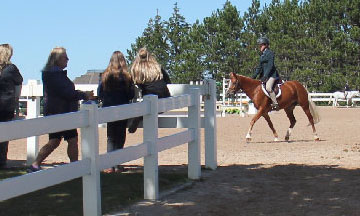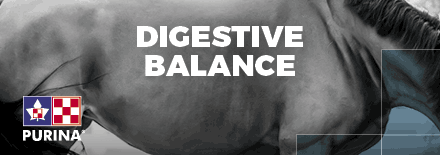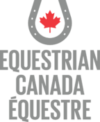Before I get to the next blog, I have to pass on some very exciting news! The Transfer Update Clinic that all existing Coach 1, 2 and 3’s have to complete to transition to the new NCCP coaching system has been organized by Equine Canada. The clinic is being delivered online as a webinar. There are tons of dates and times available for you to register and complete the clinic ASAP. Click HERE to have a look and register so you can check this requirement off your list.
Let Me Entertain You
This winter has been pretty bearable in Ontario so far, and my students are not getting bored of the four arena walls just yet, but I can feel it coming. There’s a stretch of February when it is too chilly to venture outside even for a snow hack and we are resigned to going around and around in circles in the arena again, and again. As important as it is to maintain some fitness in our ponies and students over the winter, I do find that we need to add some interesting ways to challenge our students. It’s easier to feel warm when you are having fun. And, it’s fun for the coaches too! At Oakhurst we have come up with a variety of programs that we add into our schedule in the winter. Some are competitive, some are social, some educational and a few are just team building fun. Adding something fun during our non-competitive season keeps our students competitive, happy, fit and learning. Some of the programs we have run over the past few years include:
Drill Team
Design a musical ride routine to rival the RCMP. We find great things happening when we put together students of all levels (our minimum riding requirement is the ability to trot, unassisted) and get them to work as a team to prepare for a performance. Our routines are pretty simple: pinwheels, hoedown spins, thread the needle, etc. Okay, we make the names up for the moves, but that’s part of the fun! There are several happy byproducts from this exercise. Watching the experienced riders adjust their pace to accommodate the junior riders builds teamwork within our barn; what other opportunities do junior and senior riders have to work together toward a common goal? Seeing the teams talk, plot, plan and encourage each other to work together to perform the pattern more correctly helps build that team atmosphere. As a long slow distance (LSD) workout – aerobic exercise, lots of walk and trot, no stress – our competitive students benefit from ticking one of their LSD sessions off the weekly work log. Noticing that all of the horses (and ponies) are rounder, more balanced and starting to work into the students contact, despite no one focusing on contact, balance or bend, simply because of the repeated circles, transitions, changes of pace and direction as they try to keep up with the team is something that makes all of our coaches particularly happy. Click HERE to check out one of our most recent performances to the Nutcracker at Christmas – complete with mice and soldiers.
EC Rider Level Theory
We are always helping students prepare for EC Learn to Ride Rider Level tests during their rides in lessons, but there is a lot of theory that can be covered in a warmer (not subject to toes popping off like ice cubes) environment. Pick a topic that your students need more time on and hold an hour or two-hour in-barn session looking in-depth into that topic. You can cover topics like
- Saddlery – pull every crazy bit and piece of equipment you have accumulated over the years out and get students to identify/fit them. Have a saddle fitter come in and show the kids (and adults) how to fit a saddle properly (and why!)
- Feed – Go to the local feed store or your own feed room and ask students to identify the grasses and legumes in your hay. Have them separate some sweet feed and identify its parts. Figure out how much specific horses need to eat based on their age, size, workload, temperament, etc.
- Barn Safety – Have the students make a fire or Emergency Action Plan for the barn. Get everyone to help make a list of rules for the barn. Have the students go through the first aid kits (for people and horses) and identify everything and list other “nice to have’s”.
- Lameness & Injury – Get the students to find blemishes on the school horses (c’mon, they all have SOMETHING!), identify them and talk about the cure/rehabilitation for them. Take a horse out for a jog it and check for lameness. Talk about how you would check for soundness, what a vet is looking for and what to tell a vet when you call. Have a vet come out and talk about common injuries and lamenesses.
- Bandaging – This one could always use some practice. Have everyone practice their stable, shipping, first aid, tail, polo wrap, etc. You just need a few tolerant horses who don’t mind standing still for awhile. Our school ponies love this one. It requires no real effort at all and there is always at least one student hugging them while the others work.
 Clipping and Show Prep – If you have ever seen someone clip a horse for the first time, you know it’s their first time. The horse has a very “patchwork quilt” look to them. We unleash our students on a few of the school horses in early March to learn to clip. We have one schoolie who LOVES being clipped. It’s his super secret power. He’ll stand for any clinic. Last winter we had two body clippers and a set of finishing clippers working on him all at once. He was in heaven! And it only took a few hours after the clinic to make him not look like a feral beast. He wore a blanket for a month, but hair grows back. Besides, they have to learn somehow! If you’re teaching clipping, you might as well also teach some braiding at the same time.
Clipping and Show Prep – If you have ever seen someone clip a horse for the first time, you know it’s their first time. The horse has a very “patchwork quilt” look to them. We unleash our students on a few of the school horses in early March to learn to clip. We have one schoolie who LOVES being clipped. It’s his super secret power. He’ll stand for any clinic. Last winter we had two body clippers and a set of finishing clippers working on him all at once. He was in heaven! And it only took a few hours after the clinic to make him not look like a feral beast. He wore a blanket for a month, but hair grows back. Besides, they have to learn somehow! If you’re teaching clipping, you might as well also teach some braiding at the same time.
There are so many more topics you can come up with. Look through the EC Rider Level manuals and run with your ideas. I have faith in you!
Video Clinics
Whatever it is you do, videoing it and watching it is one of the best ways to help students make the connection between what you tell them and what they are doing. I have many students who I say the same thing to frequently. I can tell that they no longer hear it, they just think I am too picky, or biased, or some kind of crazy. Usually, they’ll watch themselves for the first time and say, “Ohhh, I DO lean forward too much” or whatever it is I’ve been nagging about.
So have your students do their thing on video watch the video and then do it again after some discussion. They will improve, they can watch the video in a warm place and the riding is kept short but effective. One of the neat (I was born in the ’70s, so I can say “neat”) ideas we have come up with recently is to have our students ride a Dressage test in front of a Dressage judge and video camera. While a writer (coach) writes comments and scores on the test, the judge’s commentary is recorded on the video. That way when the video is replayed, the judges commentary is heard while the ride is being watched. The students get a great insight into what the judge is seeing and thinking. This can work in any judged discipline.
Sunday Smackdown
Some students find competing fun, but aren’t so big on the training and learning between competitions. For these students, we need to add some sneaky learning opportunities to work on the skills that need more practice – without making it seem like hard work. After introducing a new skill, one of our favourite ways to encourage our students to prefect the skill is to set up a “Sunday Smackdown.” This concept started in a lesson. We have a group of 15-year-olds who are very competitive (“I got on first” or “My horse is taller” or “I only got one rail so I won the lesson” etc.). From working with them, our head coach Ruth Allum developed the “Sunday Smackdown” challenge. Basically we pick an empty boring weekend day and challenge students to a competition in-house demonstrating the new skill being worked on. Say it’s jumping “skinny jumps.” We could run a Joker’s Wild type jumping class with several skinnies worth extra points. Or perhaps it’s working on finding a deeper seat in Dressage and we run a “no stirrups Dressage test.” If students are learning speed control, we could do a “closest to optimum time” course of jumps. The list goes on! Or maybe we can do something totally out of our comfort zone such as a hockey on horseback shootout or Mounted Games challenge. Whatever. Make it fun, a little silly and something the majority of students can try. Prepare for the taunting and rivalry and make sure there is a fabulous prize to go with bragging rights. Like a big jar of mints for the winner to keep in their locker for ponies. Creative, not expensive.
Competition Theory Clinics
- Mental Training – This year we are working with a sport psychologist to give our students an edge. They are learning valuable life and competition tools like anxiety control, deep breathing, goal setting, journaling and competition day planning. It’s a bit more than our junior students are ready for but those super competitive 15-year-olds, and the super competitive (but a little less vocal about it) adults in our program are finding it very empowering.
- Nutrition – For people. Riders don’t typically eat well on competition day. Between the early start, the attention to their horse and the availability of good choices in the middle of a field, food often gets overlooked. I find it hard to send a kid out Cross Country at 3:30 p.m. on a day that started at 5 a.m. when all they’ve eaten so far is a bacon sandwich and a hot chocolate at 7 a.m. Mistakes happen pretty quickly when your body is forced to run without fuel!
- Lunging – We don’t lunge as often as we might. Often when we ask students to lunge a horse, we end up having to teach them how to do it safely before they start. Lunging lessons (including how and why to put on all of the tack) have value in so many ways.
There are so many more topics that can fall under these clinics, too – grooming for a show, what to pack in your show trunk, corks (what, when, how, why), etc.
Games (Mounted, Prince Phillip Games, etc.)
Start a Games team – Canadian Pony Club has about 40 games under the Prince Phillip Games umbrella that are relatively easy to learn and teach. Most just require some simple equipment: a few pylons and sticks, a barrel or two, some empty plastic cups and an old feed sack or two. Or, the Mounted Games Canada website has ideas and videos to help give you some ideas. Games teach balance, confidence, agility and can help provide another competitive opportunity. And who knows, if your kids and ponies get good enough, you might find a whole new field to branch out into! The schoolies generally enjoy the change, too. We have horses in our school that are calm and predictable and old pros at their job at an event. Put a line of bending poles in from of them and a kid on top holding a baton and screaming and kicking like a banshee and they turn into weaving, lead-changing fireballs. And you swear you can see the smile on the ponies’ faces. Change is a good thing.
There are many more ideas out there. Have some fun. Encourage your students to shake off the show clothes and formal rides for a day and let loose. You’ll find the team building and joy for the fun are only a few of the great benefits of shaking things up a bit. Go for it. And let us know what you do for fun so we can add it to our winter!










